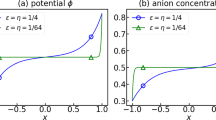Summary
A general method is presented for the formulation and numerical evaluation of mathematical models describing epithelial transport. The method is based on the principles of conservation of mass, and maintenance of electroneutrality within the cells and bathing solutions. It is therefore independent of the specific membrane transport mechanisms, and can be used to evaluate different models describing arbitrary transport processes (including passive, active and cotransport processes). Detailed numerical methods are presented that allow computation of steady-state and transient responses under open-circuit, current-clamp and voltage-clamp conditions, using a general-purpose laboratory minicomputer. To evaluate the utility of this approach, a specific model is presented that is consistent with the Koefoed-Johnson and Ussing hypothesis of sodium transport in tight epithelia (Acta Physiol. Scand. 42:298–308, 1958). This model considers passive transport of an arbitrary number of permeant solutes, active transport of sodium and potassium, and osmotically induced water transport across the apical and basolateral membranes. Results of the model are compared to published experimental measurements in rabbit urinary bladder epithelium.
Similar content being viewed by others
References
Acton, F.S. 1970. Numerical Methods that Work. p. 51. Harper and Row, New York
Carnahan, B., Luther, H.A., Wilkes, J.O. 1969. Applied Numerical Methods. Ch. 6. Wiley and Sons, New York
Civan, M.M., Bookman, R.J. 1982. Transepithelial Na+ transport and the intracellular fluids: A computer study.J. Membrane Biol. 65:63–80
Civan, M.M., Peterson-Yantorno, K., DiBona, D.R., Wilson, D.F., Erecińska, M. 1983. Bioenergetics of Na+ transport across frog skin: Chemical and electrical measurements.Am. J. Physiol. 245:F691-F700
Clausen, C., Lewis, S.A., Diamond, J.M. 1979. Impedance analysis of a tight epithelium using a distributed resistance model.Biophys. J. 26:291–318
Dwight, H.B. 1961. Tables of Integrals and other Mathematical Data. p. 132. Macmillan, New York
Forte, T.M., Machen, T.E., Forte, J.G. 1977. Ultrastructural changes in oxyntic cells associated with secretory function: A membrane-recycling hypothesis.Gastroenterology 73:941
Frizzell, R.A., Field, M., Schultz, S.G. 1979. Sodium-coupled chloride transport by epithelial tissues.Am. J. Physiol. 236:F1-F8
Fuchs, W., Hviid Larsen, E., Lindemann, B. 1977. Current voltage curve of sodium channels and concentration dependence of sodium permeability in frog skin.J. Physiol. (London) 267:137–166
Gluck, S., Cannon, C., Al-Awqati, Q. 1982. Exocytosis regulates urinary acidification in turtle bladder by rapid insertion of H+ pumps into the luminal membrane.Proc. Natl. Acad. Sci. USA 79:4327–4331
Hodgkin, A.L., Katz, B. 1949. The effect of sodium ions on the electrical activity of the giant axon of the squid.J. Physiol. (London) 108:37–77
Hull, T.E., Enright, W.H., Jackson, K.R. 1976. User's guide for DVERK—A subroutine for solving non-stiff ODE's. TR No. 100, Dept. of Computer Science, University of Toronto
Ifshin, M.S., Johnson, K.E., Eaton, D.C. 1983. Acid pH and weak acids induce Na−Cl cotransport in the rabbit urinary bladder.J. Membrane Biol. 72:151–164
Koefoed-Johnson, V., Ussing, H.H. 1958. The nature of the frog skin potential.Acta Physiol. Scand. 42:298–308
Lew, V.L., Ferreira, H.G., Moura, T. 1979. The behaviour of transporting epithelial cells. I. Computer analysis of a basic model.Proc. R. Soc. London B 206:53–83
Lewis, S.A., Moura, J.M. de 1982. Incorporation of cytoplasmic vesicles into apical membrane of mammalian urinary bladder.Nature (London) 297:685–688
Lewis, S.A., Diamond, J.M. 1976. Na+ transport by rabbit urinary bladder, a tight epithelium.J. Membrane Biol. 28:1–40
Lewis, S.A., Eaton, D.C., Clausen, C., Diamond, J.M. 1977. Nystatin as a probe for investigating the electrical properties of a tight epithelium.J. Gen. Physiol. 70:427–440
Lewis, S.A., Eaton, D.C., Diamond, J.M. 1976. The mechanism of Na+ transport by rabbit urinary bladder.J. Membrane Biol. 28:41–70
Lewis, S.A., Wills, N.K., Eaton, D.C. 1978. Basolateral membrane potential of a tight epithelium: Ionic diffusion and electrogenic pumps.J. Membrane Biol. 41:117–148
Lewis, S.A., Wills, N.K. 1981. Interaction between apical and basolateral membranes during sodium transport across tight epithelia.In: Ion Transport by Epithelia. S.G. Schultz, editor. pp. 93–107. Raven, New York
Lewis, S.A., Wills, N.K. 1983. Apical membrane permeability and kinetic properties of the sodium pump in rabbit urinary bladder.J. Physiol. (London) 341:169–184
Nelson, M.J., Blaustein, M.P. 1980. Properties of sodium pumps in internally perfused barnacle muscle fibers.J. Gen. Physiol. 75:183–206
Schultz, S.G. 1980. Basic Principles of Membrane Transport. 144 pp. Cambridge University Press, New York
Thomson, S.M., Suzuki, Y., Schultz, S.G. 1981. Current-voltage properties of the active sodium transport pathway across rabbit colon.In: Ion Transport by Epithelia. S.G. Schulz, editor. pp. 47–59. Raven, New York
Turnheim, K., Frizzell, R.A., Schultz, S.G. 1978. Interaction between cell sodium and the amiloride-sensitive sodium entry step in rabbit colon.J. Membrane Biol. 39:233–256
Wade, J.B., Stetson, D.L., Lewis, S.A. 1981. ADH action: Evidence for a membrane shuttle mechanism.Ann. N.Y. Acad. Sci. 372:106–117
Welling, L.W., Welling, D.J., Ochs, T.J. 1983. Video measurement of basolateral membrane hydraulic conductivity in the proximal tubule.Am. J. Physiol. 245:F123-F129
Wills, N.K., Lewis, S.A. 1978. Intracellular Na+ activity as a function of Na+ transport rate across a tight epithelium.Biophys. J. 30:181–186
Author information
Authors and Affiliations
Rights and permissions
About this article
Cite this article
Latta, R., Clausen, C. & Moore, L.C. General method for the derivation and numerical solution of epithelial transport models. J. Membrain Biol. 82, 67–82 (1984). https://doi.org/10.1007/BF01870733
Received:
Revised:
Issue Date:
DOI: https://doi.org/10.1007/BF01870733




